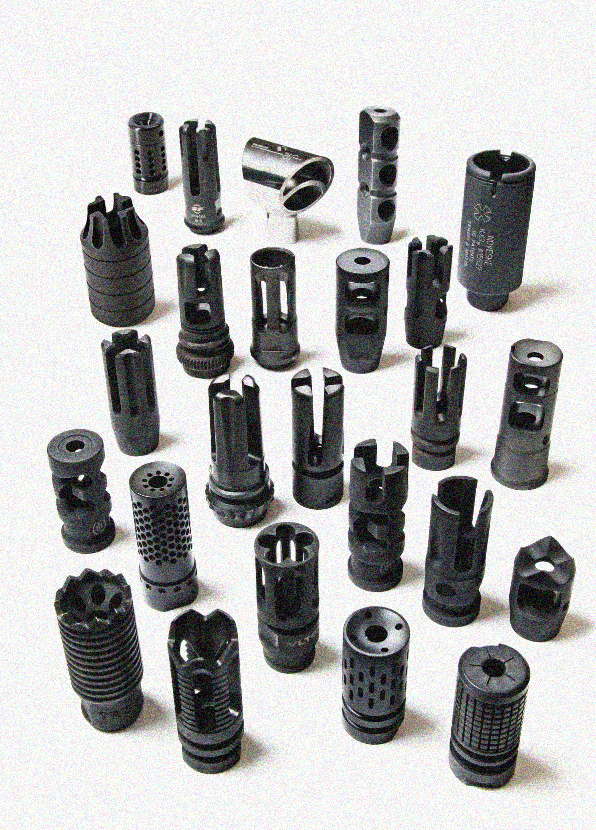A muzzle brake is a device that is attached to the muzzle of a firearm to redirect propellant gases. These gases are what push the bullet out of the barrel during firing. The main purpose of a muzzle brake is to reduce recoil. Muzzle brakes are most commonly found on high-powered rifles and shotguns.
There are several types of muzzle brakes, but the most common are:
- Ported: has holes drilled into the top and sides to release gases vertically and horizontally
- Compensator: has ports on the top to release gas upwards, reducing muzzle rise
- Flash hider: has ports or prongs that deflect gases sideways, reducing muzzle flash
When choosing a muzzle brake, you need to consider the following factors:
- The type of firearm you will be using on
- The caliber of the firearm
- Your shooting style
- The purpose of the muzzle brake (recoil reduction, muzzle rise, etc.)
You also need to take into account the added weight and length that a muzzle brake will add to your gun. This is especially important for tactical shooters who need to move quickly and keep their guns as light as possible.
If you are looking for a muzzle brake to reduce recoil on your high-powered rifle, the ported type is the best choice. If you want to reduce muzzle rise for rapid-fire shooting, then a compensator is the way to go. And if you are concerned about the flash signature, then a flash hider is what you need.
No matter what type of muzzle brake you choose, make sure it is of high quality and properly installed. A poorly made or installed muzzle brake can increase recoil and make your gun less accurate.
A muzzle brake helps to reduce the recoil of a firearm. It is attached to the muzzle, or front end, of the gun and directs gasses to move rearward when the gun is fired. This counteracts some of the force that would otherwise push forward on the gun and shooter.
Muzzle brakes can be very effective at reducing felt recoil, particularly on larger caliber weapons. They are often used on rifles and shotguns that are used for hunting or competition shooting. Some firearm manufacturers offer muzzle brakes as an option on their firearms.
Muzzle brakes come in many different designs, but most work by using a series of ports or baffles to redirect some of the gases that escape from the barrel when a round is fired. These ported muzzle brakes can be very loud, so many shooters use them only when they are shooting on a range or in an area where noise is not a concern. Some muzzle brakes are designed to reduce the amount of dust that is kicked up when the gun is fired, which can be helpful for shooters who are using a rifle with a bipod or shooting from the prone position.
A muzzle brake is a device attached to the barrel of a firearm that redirects propellant gases to counter recoil and unwanted muzzle rise. muzzle brakes are very effective at reducing recoil, and they are often used on high-powered rifles, pistols, and shotguns. Gates’ labs have shown that a typical .308 Winchester / 7.62 NATO rifle can be reduced by 20-35% with the addition of an effective muzzle brake. Muzzle brakes offer significant advantages for both competition shooters and hunters.
The main advantage of a muzzle brake is the decrease in felt recoil, which allows the shooter to maintain control of the firearm for follow-up shots and makes shooting more comfortable overall. In addition, muzzle brakes can help reduce shooter fatigue, and they can minimize the effects of muzzle rise, which makes it easier to keep the sights on target during rapid fire.
A muzzle brake is a device that’s attached to the muzzle of a firearm to redirect some of the gases that are produced when the weapon is fired. This can reduce the amount of felt recoil, making it easier for the shooter to control their weapon. Muzzle brakes are commonly used on high-powered rifles and shotguns, but they can be found on pistols and even airguns as well.
So how do muzzle brakes work? When a round is fired, hot gases are expelled from the barrel out through the muzzle. A muzzle brake has ports or baffles that allow some of those gases to escape to the sides, instead of straight out the front. This helps reduce the rearward force on the gun, making it easier to control.

Muzzle brakes are commonly used on high-powered rifles and handguns, particularly those with large calibers. Having a muzzle brake can be a huge help when firing these types of weapons, as they can drastically reduce felt recoil. This can be especially valuable for shooters who are already struggling to handle the heavy recoil of these guns.
Please login or Register to submit your answer



